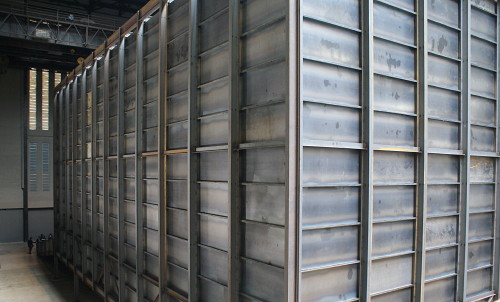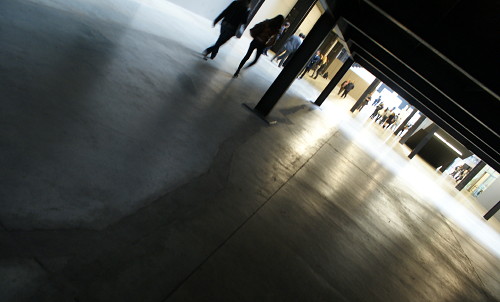
Miroslaw BalkaLondon, Tate Modern, Turbine hall 2009

Turbine hall, Miroslaw Balka
|
Terrifying darkness for hidden memories… an experience for our mind, body and limits.
"Shall I move ahead, it is so dark here! But where does it end? Shall I stop here, I might fall and hurt myself. And all these people around are so noisy. Shouting, bumping into each other. What should I be afraid of? It is just a game. May be I should skirt along the walls, this soft velvet black coat is an invitation to caress them, to keep close to their comforting touch. This fury touch is of reassurance for us. It is so dark in here!" We are at the Tate Modern. Along the floor a huge scar is a remnant of the work of Doris Salcedo, Shibboleth a subterranean chasm that stretched the length of the Turbine Hall 2 years ago. The huge Turbine Hall is now occupied by a weird structure, a rusted metal block on stilts mimicking both a mysterious temple and a shipping container. Going inside this dark massive mouth, I recall climbing the stairs of the Tikal ruins in Guatemela. These very stairs a prince martyr used to climb before priests would immolate him. Again, it is here all about experiencing our body, our imagination, our fears and mind, through a very symbolic and minimalist installation, a project that invites visitor interaction. After the "Weather project" conceived by the Danish artist Olafur Eliason experiencing light and no space limits, or the funny slides of Carsten Holler, the Turbine hall welcomes the artist Miroslaw Balka. Born in 1958 in Poland, where he works and lives a simple life, close to his roots, this artist always worked in Arte Povera by necessity, because since his early childhood, he made with what he had at hand. "Including installation, sculpture and video, his works explore themes of personal history and common experience, drawing on his Catholic upbringing and the fractured history of Poland. Intimate and self-reflective, his works demonstrate his central concerns of identifying personal memory within the context of historical memory." On the second floor a video can be seen which gives a better insight to the installation and the container experience, allowing a daring but fertile parallel. An exploration of solitude, memory, sadness and love for family. An exploration of absurdity. We take the train to Treblinka, sky is dark, it is rainy, landscape is empty, lifeless, almost petrified. The artist wonders what Jewish people might have felt during this endless trip. He questions their hope, their doubts. Till the last moment they must have looked at all this with total disbelief, wondering what could happen next. They must have concluded they would be needed, could be useful working, must have hoped till the end the nightmare would end, even in the final shower, full of hope… Edith Herlemont-Lassiat
London, november 2009
Tate Modern dLondon - October 13 2009 - April 5 2010
www.tate.org.uk/modern/ |

Turbine hall, Doris Salcedo fracture